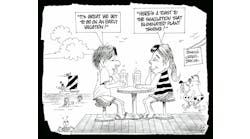The plant had started up on graphics that closely resembled the then-current generation of Honeywell’s Universal Station, even though the DCS was not Honeywell. A few years later, grayscale graphics were being advocated, where color unrelated to alarms or abnormal conditions was muted. Instead of yellow numbers for process variables, graphical representations were favored. I recall explaining to the plant manager how DoD studies had shown how fighter pilots could comprehend and react to bar graphs and pictograms much faster than numbers, giving them an edge in combat. His response, and I paraphrase, “Why would I want my operators to have to react like fighter pilots?"
Clarence “Kelly” Johnson of the famed Lockheed Skunk Works, creators of the first stealth aircraft as well as the fastest and highest-flying spy planes yet created, insisted his engineers were never more than a few dozen yards from the production floor. His successor, Ben Rich, relates how Kelly had one of his test pilots take him along on a flight as least once a year, which was terrifying but cemented his own dedication to serving the ultimate end user. For our plant, there was a deeper point for engineers to internalize: disruptive graphics changes were going to foment an obstacle to operators understanding and forming mental models of the novel process.
Operators are tasked with spending eight to 12 hours or more at a time staring at graphics created by engineers. And they’re expected to navigate the plant with optimal safety, productivity and efficiency without breaking anything. I remember a talk given by a brewer who discovered he could change the graphics on his European-made brewing kit’s control system. While a complete novice in the realm of process control, he hilariously observed the graphics were “designed by engineers who had no idea what we needed to look at.”
Advocates for high-performance graphics and abnormal situation management may view this with some dismay, but their efforts and insights are not in vain. After hearing the complaints and admonitions of operators, the site’s graphic designers began a more phased and gradual approach, beginning by limiting colors and making some of the bright yellows and oranges of the originals more muted or grayscale. An offline pump was gray instead of red, for example. With the advent of new 16:9 widescreen, flat-panel monitors, designers began rolling out more consolidated and task-focused graphics, which also employed a color scheme closer to grayscale (but not vastly different from the originals). Operators, given the option to utilize either set of graphics, began using the newer ones more often. With successive updates, additional distracting color choices were replaced as well.
Listen and respond
That we’re better when we work with the “victims” upon whom we inflict our hopefully useful designs is not exactly a novel concept, but it’s surprisingly rare in some cultures. Collaboration with end users—constructors, operators, maintainers—functioning in the “real world” and incorporating their feedback—adjusting our designs to better suit their needs—not only begets a project more likely to succeed, it helps with utilization and end-user buy-in. Once a unique strength and path to innovation at which we excelled, how much has our year of a pandemic-hogtied culture robbed from us? A command-and-control hierarchy, where the smart guy at the top disseminates direction and knowledge down the pyramid to the front lines, functions as well with Zoom or Team meetings as it does in person. But seeing one’s solution gathering dust in a deserted corner can be a better catalyst for improvement than sad phone calls from the engineer who installed it. Joining your customer in struggling to use it in the real world is even better.
Zoom and Teams may mean we save on travel and commutes, and we’re getting involvement from contributors whose travel is more constrained. More end users can engage with standards committees, for example. But let’s not neglect the increasingly atrophied muscle of in-person collaboration that's been taken from us. Our ability to hear and incorporate ideas and feedback from the front line: it may be the path to distinctive innovation.






